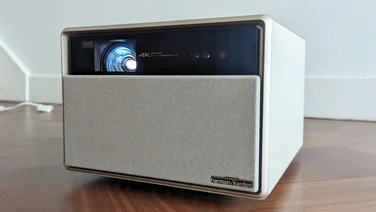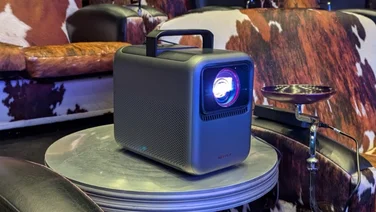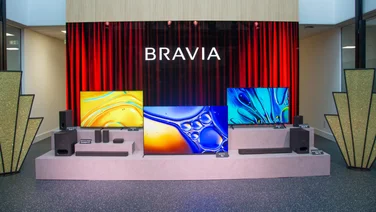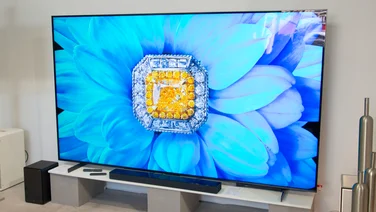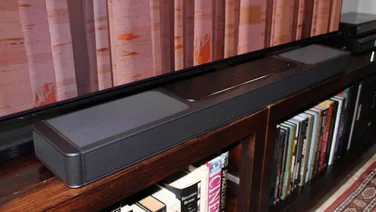To help us provide you with free impartial advice, we may earn a commission if you buy through links on our site. Learn more






- Extremely compact soundbar
- Assertive, full-range sound
- Ample control options
- Lacks sonic scale
- Sub and soundbar crossover issues
- Worthwhile competition
If you want to upgrade the audio quality of a small TV without spending loads or buying a hulking great soundbar, the Yamaha SR-C30A is a budget soundbar that should definitely be on your radar.
As far as detail retrieval, low-frequency presence and mid-range positivity are concerned, the SR-C30A is a decisive step up from the sound your TV makes. And, like all Yamaha products, its properly made and finished. It has plenty of well-implemented control options and is so small youll hardly notice its there unless its powered up and working.
But a rather ham-fisted handover between soundbar and subwoofer, a predictably small-scale audio presentation and some very decent (although admittedly larger) alternatives mean its not a default choice.
Yamaha SR-C30A review: What do you get for the money?
£299 put Yamahas way for the SR-C30A buys what looks very much like a scale model of a soundbar, accompanied by a wireless subwoofer thats pretty small in absolute terms but is made to look rather hefty by the soundbar it accompanies. As the asking price strongly suggests, this is a functional product rather than one that’s going to indulge you with lavish materials or a metre-long feature set.
At 600 x 94 x 64mm (WDH), this is one of the most compact soundbars weve encountered, with only the Polk MagniFi Mini AX taking up less space on your TV stand. Those dimensions are exactly the same as 2021’s SR-C20A, but the SR-C30A is differentiated from its more affordable sibling by the inclusion of a wireless subwoofer.






The bar itself is small enough to sit beneath small TVs or gaming monitors without drawing visual attention to itself, and at 1.3kg its easy enough to take from room A (where the TV is) to room B (where the gaming monitor is). There are a couple of keyhole mounting points on the rear of the chassis, in case you want to hang it up rather than position it on a shelf.
The wireless subwoofer element of the system is a slightly less startling 160 x 364 x 335mm (WDH) but is still pretty compact and capable of delivering 50W of Class D power. It has a forward-firing bass reflex port, a side-firing 130mm bass driver and a pairing button in case it doesnt automatically get acquainted with the soundbar when its first powered up.
The soundbar, naturally, has a bit more going on. Its fitted with a pair of 46mm full-range drivers, each powered by 20W of Class D amplification this is staunchly a 2.1-channel system with no ambitions beyond making the unassisted sound of your TV seem a bit feeble. There are physical connections on the rear panel: HDMI ARC, a couple of digital optical sockets, a 3.5mm analogue input and a USB slot thats only for servicing. Wireless connectivity, meanwhile, is handled by Bluetooth 5.0, with SBC and AAC codec compatibility.
Build quality is perfectly acceptable, as are the materials Yamaha has deployed. Much of the soundbar is covered with acoustic cloth, and theres more of the material over the front of the subwoofer as well as covering its side-firing driver. The rest of the soundbar is plastic, while the subwoofer is mostly chipboard. So functional is this system in the way it looks, in fact, that the glossy plastic trim around the subs reflex port almost counts as a design flourish.






Yamaha supplies a full-function remote control with the SR-C30A. Like the system itself, its not what youd call a looker, but it gets the job done. It allows you to adjust overall volume, trim the subwoofers output independently, access four EQ presets Stereo, Standard, 3D Movide and Game as well as access Clear Voice, which pushes the mid-range forward in the name of intelligibility, and Bass Ext, which beefs up the low-end extension. Youre also able to cycle through the various inputs, mute the bar, power it off and adjust the brightness of the little row of LEDs behind the soundbars acoustic cloth on its front panel. These can be turned off altogether should you prefer.
All of these functions are duplicated on the Yamaha Sound Bar Remote Control app thats available free for Android and iOS. Its as staunchly unglamorous as the rest of the SR-C30A package, but its equally reliable and usable. And if youre a particularly hands-on sort of person, power on/off, input selection and volume adjustment are available via capacitive touch controls on the soundbars top surface.
READ NEXT: Our favourite subwoofers
Yamaha SR-C30A review: What do we like about it?
In its primary task sounding considerably more convincing than your average mainstream TV the Yamaha SR-C30A performs admirably. Theres greater impetus to its sound, greater directness and positivity than a bog-standard television has a hope of delivering by itself, and the amount of low-frequency presence the Yamaha generates is utterly beyond any TV that doesnt have a dedicated audio system of its own.
Throughout the frequency range, the SR-C30A retains and serves up plenty of detail; its attentive enough to keep on top of even the most minor, most transitory elements of a soundtrack and report back on them. When you remember that it has no dedicated tweeters, the high frequencies it generates are crisp, substantial and, yes, high and the subwoofer has little difficulty delving deep into the bass regions and hitting with real determination. Its no blunt instrument, though: it controls the attack and decay of individual sounds well, and carries just as much information regarding timbre and texture as the soundbar it accompanies.






This low-end authority leads to decent rhythmic expression when listening to music (or the musical elements of a movie soundtrack), and although the overall soundstage the Yamaha creates isnt what youd call expansive, its coherent. Theres just about enough breathing space for each individual thread of a soundtrack to do its thing without worrying about being crowded out.
Its the mid-range, though, thats probably the single most enjoyable aspect of the SR-C30As performance. Voices are loaded with fine detail of tone and texture, which means dialogue is characterful and distinct. The Yamaha projects dialogue well, so even when the going gets noisy, busy, or both, youre never in any danger of losing access to voices, and the positivity of this presentation means its easy to follow whats what even when listening at reasonably low volume levels.
READ NEXT: Best Dolby Atmos soundbar
Yamaha SR-C30A review: What could be improved?
Shortcomings are few here, but they exist. And primarily, they centre on the relationship between the soundbar and the subwoofer.
It becomes evident quite quickly that the soundbar doesnt reach particularly far down the frequency range: the bottom of the mid-range is about the limit of its extension. This means the subwoofer has quite a lot of responsibility beyond the crashes, bangs and wallops that bass boxes normally restrict themselves to. And while it does its utmost, the crossover point between the subwoofer and the soundbar is always apparent, mostly because where they meet, their tonality is quite distinct. The soundbar is forward and direct, while the subwoofer is a little less positive and a little less upfront. So rather than a seamless journey from the top of the frequency range to the bottom, the line is a little bit bumpy.






Its most apparent when you stream some music (or when your movie soundtrack becomes music-centric). Finessing the subwoofers volume level relative to the soundbar using the remote control or the app can mitigate this trait, but not eradicate it.
The other pertinent issue, which is of lower intensity but apparent nevertheless, concerns the straightforward scale of sound the SR-C30A produces: theres just not that much of it. Perhaps its to be expected, given the small proportions of the system itself, but for all that it can create a persuasive soundstage, the Yamaha doesnt sound any bigger than it looks. If youre going to be using it in conjunction with a smaller TV or a gaming monitor, this is unlikely to be much of an issue, but beneath a larger screen or in a larger room, the sound will probably seem localised and a little confined.
Yamaha SR-C30A: Should you buy it?
Theres an awful lot to like about the Yamaha SR-C30A. Theres the discreet, unshowy proportions, the quality of the build and finish, and the detailed, direct sound. Its not without its issues, and its not without competition, but good luck finding a soundbar this small with such a big list of talents.

